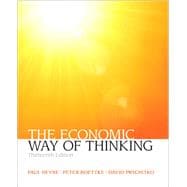Intended primarily for one semester survey courses in general economics, this text also provides practical content to current and aspiring industry professionals.
Learn how to think like an economist.
The Economic Way of Thinking goes beyond explaining the basic principles of micro- and macroeconomic analysis by showing readers a method of reasoning that teaches them how to apply these principles as tools. The authors expose readers to a method of reasoning that makes them think like an economist through example and application and also shows them how not to think, by exposing errors in popular economic reasoning.
The latest edition has been thoroughly updated with current material.











